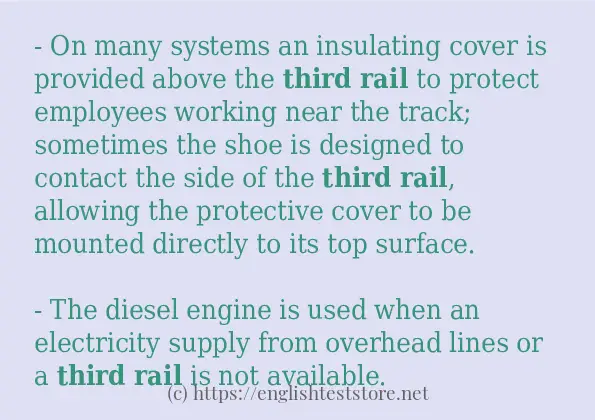How to use in-sentence of “third rail”:
– On many systems an insulating cover is provided above the third rail to protect employees working near the track; sometimes the shoe is designed to contact the side of the third rail, allowing the protective cover to be mounted directly to its top surface.
– The diesel engine is used when an electricity supply from overhead lines or a third rail is not available.
– A third rail is a metal railway track that is placed on either side of a train track to provide electricityelectrical power to trains traveling along the tracks.
– Siemens’ electric locomotive was the first train to use a third rail and power was provided by a dynamo built for this purpose.
– The 507s were the first variant to be 750V DC third rail only.

Example sentences of “third rail”:
– In 2005 American James Maki fell onto the third rail at a Boston rail station and suffered extensive and disfiguring injuries.
– There is a mixture of third rail and overhead line electric power supply.
– It is also the first line where trains get their power from Overhead linesoverhead wires above the track, instead of a third rail beside the track.
– The third rail is usually located outside the two running rails, but occasionally between them.
– Power was supplied from a third rail at 625 Volts direct current.
– Part of the TGV family, it has a smaller cross-section to fit within the constrictive British loading gauge, was originally able to operate on the UK third rail network, and has a lot of fireproofing in case of fire in the tunnel.
– The British Rail Class 504 was a unique type of electric multiple unit that ran on 1200 V DC third rail with side-contact current collection.
– Like most subways, the Toronto subway/RT trains get electricity from a third rail that runs next to the tracks.
- In 2005 American James Maki fell onto the third rail at a Boston rail station and suffered extensive and disfiguring injuries.
- There is a mixture of third rail and overhead line electric power supply.
– The British Rail Class 450 third rail DC EMU began service during 2003.
– Whilst many modern long distance trains use an overhead wire system to provide power, the third rail was the first successful means of supplying power.
– Class 319 units have dual power pick-up, from either 25 voltkV alternating current third rail to the south.
– Electric trains get their power from a third rail or from overhead wires.
– British Rail Class 415 was a suburban 750V Direct currentDC third rail electric multiple unit commissioned by the Southern Region of British Railways.
